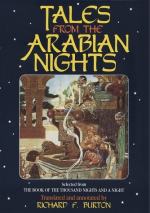The traditional hatred of Al-Hajjaj was envenomed by the accession of the Abbasides and this dynasty, the better to distinguish itself from the Ommiades, affected love for the Holy Family, especially Ali and his descendants, and a fanatical hatred against their oppressors. The following table from Ibn Khaldun (Introduct. xxii.) shows that the Caliphs were cousins, which may account for their venomous family feud.
[First Version]
’Abd Manaf | ____________|____________ | | Hashim Abd Shams | | Abd al-Muttalib Umayyah | | ___________|__________ ____|______ | | | | | Al-Abbas Abdullah Abu Talib Harb Abu ’l-Aus | | | | | Abdullah Mohammed | Abu Sufyan Al-Hakim | | | | | Ali Fatimah married Ali Mu’awiyah Marwan | _____|_____ (1st Ommiade) | | | Mohammed Al-Hasan Al-Husayn | Al-Saffah (1st Abbaside)
[Second Version]
’Abd Manaf, father of Hashim and Abd Shams
Hashim, father of Abd al-Muttalib
Abd al-Muttalib, father
of Al-Abbas, Abdullah, and Abu Talib
Al-Abbas,
father of Abdullah
Abdullah,
father of Ali
Ali,
father of Mohammed
Mohammed,
father of Al-Saffah (1st Abbaside)
Abdullah,
father of Mohammed
Mohammed,
father of Fatimah, who married Ali
(son
of Abu Talib)
Fatimah,
mother of Al-Hasan and Al-Husayn
Abu
Talib, father of Ali
Abd Shams, father of Umayyah
Umayyah, father of Harb
and Abu ’l-Aus
Harb,
father of Abu Sufyan
Abu
Sufyan, father of Mu’awiyah (1st Ommaide)
Abu
’l-Aus, father of Al-Hakim
Al-Hakim,
father of Marwan
[FN#44] [The word here translated “invited guest” reads in the Ms. “Mad’ur.” In this form it is no dictionary word, but under the root “D’r” I find in the Muhit: “wa ’l-’amatu takulu fulanun da’irun ya’ni ghalizun jafin” = the common people say such a one is “daiir,” i.e., rude, churlish. “Mad’ur” may be a synonym and rendered accordingly: as though thou wert a boor or clown.—St]
[FN#45] A neat specimen of the figure anachronism. Al-Hajjaj died in A.H. 95 (= Ad 714), and Cairo was built in A.H. 358 (= Ad 968).
[FN#46] Perfectly true in the present day. The city was famed for intelligence and sanguinary fanaticism; and no stranger in disguise could pass through it without detection. This ended with the massacre of 1840, which brought a new era into the Moslem East. The men are, as a rule, fine-looking, but they seem to be all show: we had a corps of them in the old Bash-Buzuks, who, after a month or two in camp, seemed to have passed suddenly from youth into old age.




